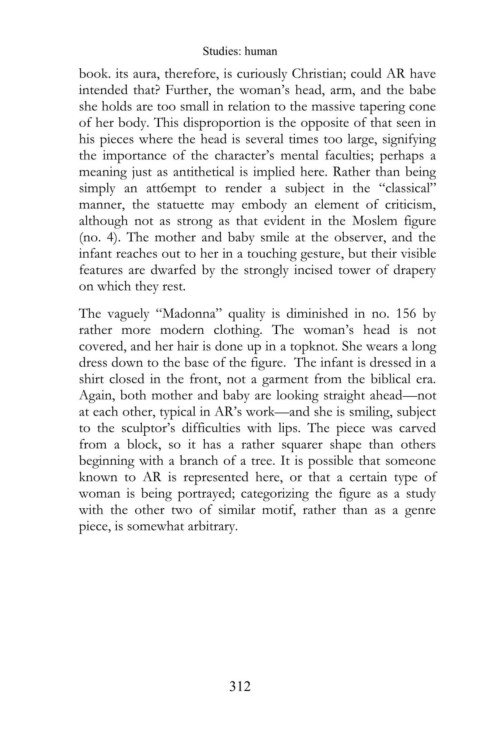Page 316 - The Legacy of Abraham Rothstein - text
P. 316
Studies: human
book. its aura, therefore, is curiously Christian; could AR have
intended that? Further, the woman’s head, arm, and the babe
she holds are too small in relation to the massive tapering cone
of her body. This disproportion is the opposite of that seen in
his pieces where the head is several times too large, signifying
the importance of the character’s mental faculties; perhaps a
meaning just as antithetical is implied here. Rather than being
simply an att6empt to render a subject in the “classical”
manner, the statuette may embody an element of criticism,
although not as strong as that evident in the Moslem figure
(no. 4). The mother and baby smile at the observer, and the
infant reaches out to her in a touching gesture, but their visible
features are dwarfed by the strongly incised tower of drapery
on which they rest.
The vaguely “Madonna” quality is diminished in no. 156 by
rather more modern clothing. The woman’s head is not
covered, and her hair is done up in a topknot. She wears a long
dress down to the base of the figure. The infant is dressed in a
shirt closed in the front, not a garment from the biblical era.
Again, both mother and baby are looking straight ahead—not
at each other, typical in AR’s work—and she is smiling, subject
to the sculptor’s difficulties with lips. The piece was carved
from a block, so it has a rather squarer shape than others
beginning with a branch of a tree. It is possible that someone
known to AR is represented here, or that a certain type of
woman is being portrayed; categorizing the figure as a study
with the other two of similar motif, rather than as a genre
piece, is somewhat arbitrary.
312

